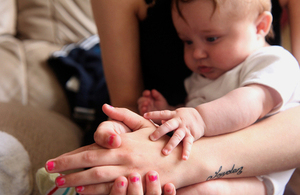Under 18 conception rate in England continues to fall
New Office of National Statistics (ONS) figures show the conception rate among teenagers is at an all-time low.

Public Health England (PHE) welcomes new figures showing the conception rate among under 18 year olds dropped by 12.3% to 24.3 per 1000 in 2013, the lowest since records began. The under 16 conception rate for 2013 is 4.8 per 1000 females aged 13 to 15, a 14.3% reduction from 2012.
Since 1998, the under 18 conception rate has decreased by 47.9% - with reductions of over 60% in some top tier local authorities in England during this period. However, there remain significant variations in the under 18 conception rate across the country with the rate in some areas significantly higher than the England average.
Professor Kevin Fenton, National Director of Health and Wellbeing at PHE, said:
Today’s data show us high conception rates can be reduced and young people’s sexual health can be improved if they receive the right support. Young people who have the highest rate of unplanned pregnancy and teenage parenthood can be at risk of a range of poor outcomes, such as poor educational achievement, poor physical and mental health, social isolation and poverty, so it is vital this downward trend is continued.
One of PHE’s 7 national priorities is ‘ensuring every child has the best start in life’. We are committed to supporting local government and partners to further reduce under 18 conception rates because we know this is generally better for both parents and their children.
Alison Hadley, Teenage Pregnancy Knowledge Exchange Director at the University of Bedfordshire, and PHE advisor on this issue said:
The significant reduction is proof that concerted effort, evidence based approaches and significant time can make a difference to complex public health issues. The success on teenage pregnancy has been achieved by local leadership, the commitment of frontline practitioners and strong partnership working between agencies. The challenge now is maintaining a ‘whole systems’ approach in the new commissioning landscape, and with fewer resources.
Despite the 48% drop since 1998, young people in England continue to experience higher levels of teenage pregnancy than their peers in comparable Western European countries so a continued focus is essential. International evidence and lessons from the most successful local areas show the key ingredients of success are comprehensive sex and relationship education, in and out of school, easy access to young people-centred contraceptive and sexual health services, more intensive prevention for those most at risk and coordinated support for young parents.
Background
-
The 2013 conception data are available on the ONS website. For data queries, contact the ONS press office on 0845 604 1858 or by email at media.relations@ons.gsi.gov.uk.
-
Reducing the under 18 and under 16 conception rates is one of the key priorities of the Department of Health’s Framework for Sexual Health Improvement (2013), which asks local authorities to work with partners to use the evidence base and learning from successful areas to make further progress.
-
The previous Government set a target to halve the teenage conception rate in England by 2010 when compared with 1998. The Teenage Pregnancy Strategy ended in 2010 but the Public Health Outcomes Framework (PHOF) 2013 to 2016 includes ‘under 18 teenage conception rate’ as one of three sexual health indicators. Further reductions in teenage pregnancy and improved support for young parents also contributes to a number of other indicators in the PHOF that disproportionately affect teenage parents and their children.
-
Public Health England exists to protect and improve the nation’s health and wellbeing, and reduce health inequalities. It does this through world-class science, knowledge and intelligence, advocacy, partnerships and the delivery of specialist public health services. PHE is an operationally autonomous executive agency of the Department of Health. Website: www.gov.uk/phe. Twitter: @PHE_uk, Facebook:www.facebook.com/PublicHealthEngland